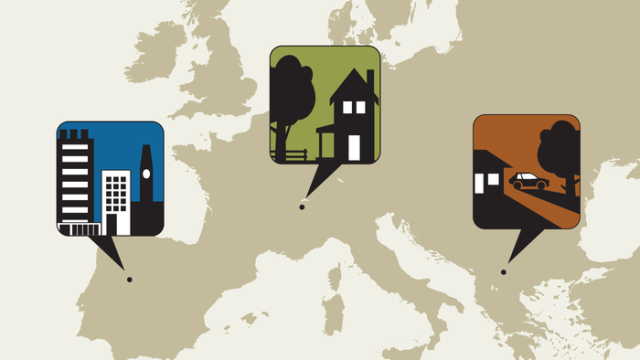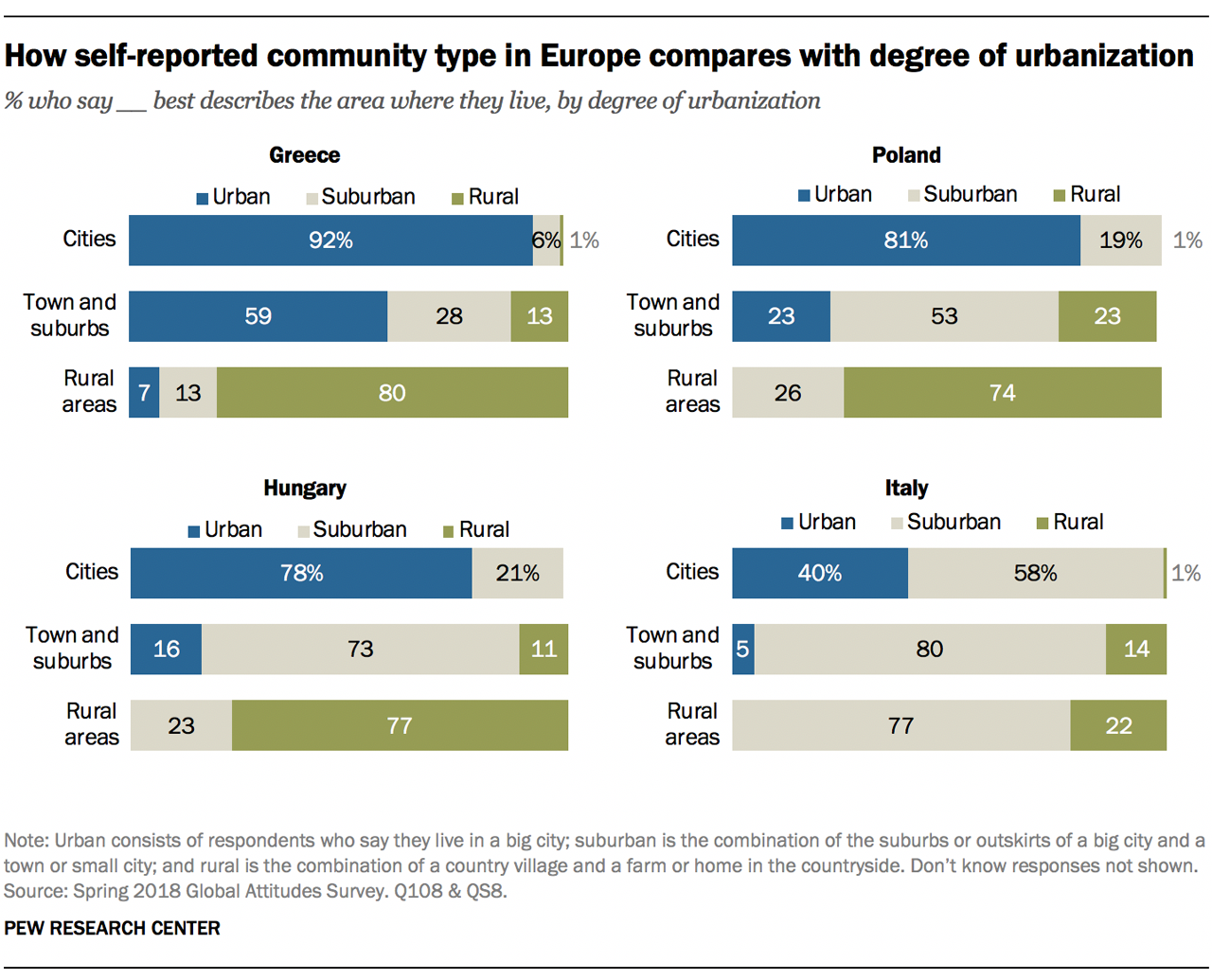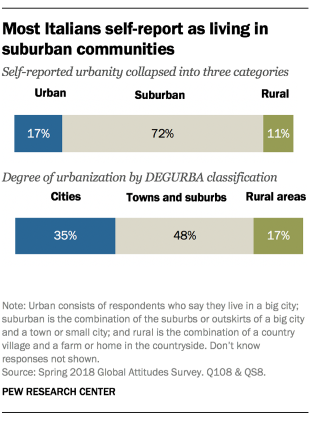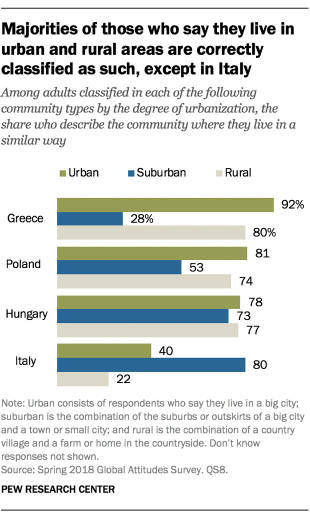
Related posts: Evaluating what makes a U.S. community urban, suburban or rural and Urban, suburban or rural? Americans’ perceptions of their own community type differ by party)
In a recent post, we highlighted some of the complications of determining whether communities in the United States are urban, suburban or rural, as well as how official government measures can differ from how survey respondents describe their own communities.
This isn’t just a challenge in an American context. In this post, we’ll look at how the same issue can arise internationally.
Background
A Pew Research Center survey conducted in the spring of 2018 asked people in four European countries — Greece, Hungary, Italy and Poland — to identify what kind of community they live in. Surveys were conducted face-to-face and stratified by urbanity using the degree of urbanization (DEGURBA), which allowed us to compare respondents’ self-reported community type to official government classifications.

Overall, around a third (34%) of the 4,103 respondents across these four countries described the area where they live as a “big city.” Roughly a quarter said they live in a “town or small city” (28%) or a “country village” (25%). Smaller shares described their community as “the suburbs or outskirts of a big city” (11%) or “a farm or home in the countryside” (2%).
To make these descriptions comparable to outside measures of population density, we collapsed the self-reported measures into three categories: urban, suburban and rural (the same categories we use in the U.S.). Those who identified as living in a big city are classified as urban. Those who said they live in the suburbs or outskirts of a big city, along with those in a town or small city, are considered suburban. Those who described their community as a country village or said they live on a small farm or home in the countryside are coded as rural.
Using the collapsed measures, 34% of respondents in the four European countries surveyed are considered urban, 40% are considered suburban and 27% are considered rural.
An outside measure of community type
As is the case in the U.S., outside measures are also available for determining community types in Europe. One such measure is the DEGURBA, which is used to stratify our European surveys by urbanity. This measure was developed by the European Commission, the Joint Research Center and Eurostat.
This measure classifies communities based on geographical contiguity, population density and minimum population thresholds. These criteria are then applied to 1 km² square grid cells to avoid any distortions caused by pre-existing geographic boundaries. Each local administrative unit is classified into one of the three types of areas: cities, or densely populated areas, where at least 50% of the population lives in urban centers with a minimum of 50,000 inhabitants; towns and suburbs, or intermediate density areas, where at least 50% of the population lives in urban clusters and less than 50% of the population lives in urban centers with a minimum of 5,000 inhabitants; and rural areas, or thinly populated areas, where at least 50% of the population lives in rural grid cells.
How the outside measure compares with self-reporting
Apart from Italy, we found that self-reported community type was strongly related to the DEGURBA classification.
In Greece, Hungary and Poland, more than three-quarters of those who are classified by DEGURBA as living in a city or densely populated area also self-identify as living in an urban area. Similarly, in these three countries, around three-quarters or more of those who are classified as rural by the official measure also self-identify as living in a rural area.

Still, even in the three countries where some self-reported measures compared well to the official measure, there are some mismatches. In Greece, for example, 59% of those who are classified by the official measure as living in a suburban area say their community is urban, and 7% of those who are classified as living in a rural area describe their community as urban.
In Italy, there is a weaker relationship between self-reported community type and the official measure. Using the DEGURBA classification, 35% of Italian survey respondents are categorized as living in cities, 48% as living in towns or suburbs and 17% as living in rural areas. In our survey however, a majority of Italian respondents self-identified as living in a suburban area. Large shares of those who describe their community as suburban are classified into each of the three DEGURBA categories.

Conclusion
With the exception of Italy, DEGURBA closely resembles self-described community types for urban and rural areas in the countries we examined. More than three-quarters of adults in Greece, Hungary and Poland who say they live in an urban area are classified that way by the outside measure. And more than seven-in-ten who describe their community as rural are similarly defined as living in a rural area by DEGURBA.

While Italians’ description of their community type does not map well onto the DEGURBA classification scheme for either urban or rural areas, the objective measure still performs well for Italians who describe their community as suburban, with 80% classified correctly.
Coding decisions in our analysis offer one possible explanation for the mismatch between self-reported suburbanites in Italy and the DEGURBA classification scheme. In order to make the self-reported measure more comparable to the objective measures, we defined a suburban area as the suburbs or outskirts of a big city or a small town or city, which may have played a role in our results for Italy. More than twice as many Italians (25%) than Greeks (7%), Hungarians (4%) or Poles (8%) say they live in the suburbs or outskirts of a big city. Similarly, more Italians (47%) describe their community as a town or small city than their European counterparts (37% of Hungarians, 23% of Poles and 7% of Greeks, respectively). Another potential explanation, as evidenced by the data above, is that Italians have a different understanding of what it means to be suburban than their European neighbors.
Correction: An earlier version of this post referred to the shares of people in some countries who self-identify as living in urban, suburban or rural areas. These figures actually reflect the shares of people in these countries who are classified by DEGURBA as living in urban, suburban or rural areas.